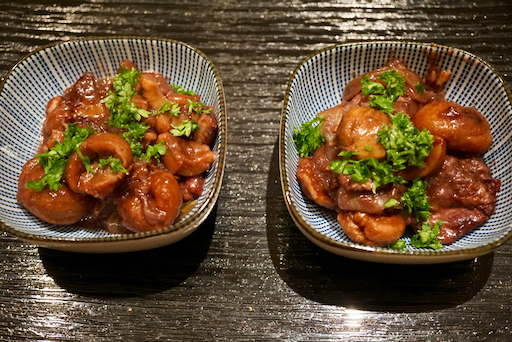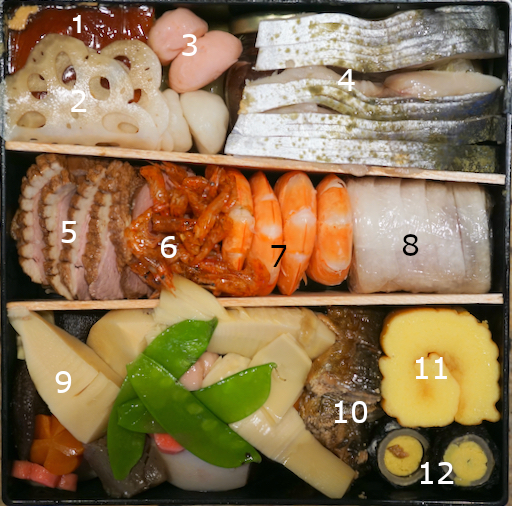We like pancakes for breakfast sometimes. One of the unusual ones we like to make is
chestnut flour pancake”. Since we are now in the chestnut season, we decided to have the chestnut flour pancake for breakfast one weekend. We keep all exotic and whole grain flours including the chestnut flour in a small freezer in the basement. When my wife got it out, she realized its BUB (best used by) was in 2015. It smelled ok. We went ahead and made the pancakes which were very good but even by our standards this flour was a bit too far past its BUB. We decided it is the time to buy a new batch. We got a couple of bags of chestnut flour and my wife looked for some new recipes to use it. She came across this recipe for chestnut flour cake
on-line. Actually, she made a chestnut flour cake with the same Italian name “
Castagnaccio”
previously. But that cake was quite different from this one. It was very savory and did not use any leavening agent, or sugar but did use fresh rosemary which provided good flavor. Overall, however, we were not crazy about it because it was rather dry and crumbly. The new recipe she found must be a variation of an Italian generic cake called castagnaccio. In any case, the major differences are this cake uses a leavening agent, sugar and coco powder. Instead of herbs such as rosemary this used a combination of nuts and candied fruit. It is much thicker as well. This version is more suitable for breakfast or dessert than the previous version which was more savory and as the original recipe suggested “should be washed down with red wine”. The common thing is that both cakes are quite crumbly. (We ended up eating both of them as crumbs with a spoon.)
Ingredients1 1/2 cups chestnut flour
1/3 cups sugar
1 tablespoon baking powder
2 tablespoons cocoa powder, plus more for dusting
Pinch of salt
1/2 cup extra virgin olive oil, plus more for brushing
2 tablespoons honey, plus more for serving
2 large eggs
1 cup milk
1 cup of Harry and David’s medley of candied fruit. (The original recipe calls for 1/2 cup raisins and 1/2 cup dried cranberries, plumped in 1/4 cup warm water or wine - preferably Vin Santo).
1/3 cup toasted pine nuts
1/3 cup roughly chopped toasted walnuts (As added measure we added chopped chestnuts)
Confectioner's sugar for dusting
Directions:Preheat oven to 350F degrees. Prepare a 9-inch cake pan (The original recipe suggested lightly greasing it with olive oil but we had trouble getting the cooked cake out of the pan. We suggest next time greasing the bottom of the pan and adding a layer of greased parchment paper.)
Toast the pine nuts and walnuts. In a large bowl, swift together the flour, sugar, baking powder, cocoa powder and salt. In a separate bowl, whisk together the olive oil, honey, eggs and milk. Slowly pour the liquids into the dry ingredients, whisking very well to avoid lumps. The batter should be smooth and a bit liquid. Add the nuts and dried fruit. Pour the batter into the prepared pan, and bake for 35 minutes, or until the cake begins to puff slightly and the middle is set. Remove from the oven and cool completely before removing from pan.
Dust lightly with confectioner's sugar and cocoa powder and serve with some warm honey.
We found it was difficult to remove the cake from the pan. A portion of it stuck to the pan and crumbled. (See the picture below). (Next time, we will use buttered parchment paper on the bottom of the pan). Even the portion that came out in one piece was difficult to cut into wedges since it kept crumbling. The only good thing was that even the crumbs tasted good.
Although eaten in crumbs this cake was very good. The chestnut flour added a nuttiness to the overall chocolate flavor. The pine nuts, walnuts and dried fruit added little bursts of flavor and texture. The dried fruit was particularly nice because it added a burst of sweetness. Interestingly, over time the chestnuts we added became rock hard and we had to be careful to remove them from every mouthful. We liked this cake better than the previous version my wife made. It would just be nice if it did not disintegrate into crumbs.





















































